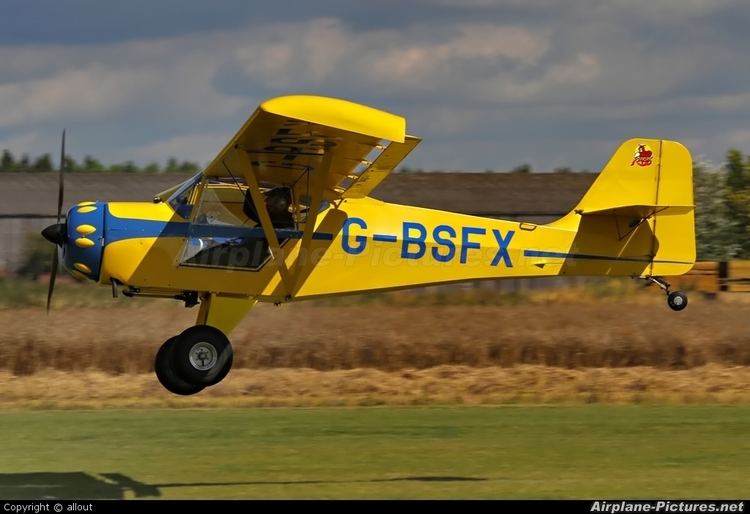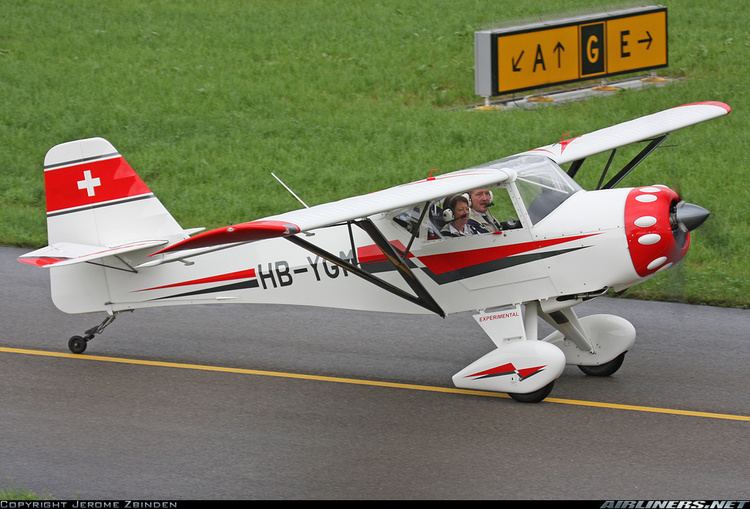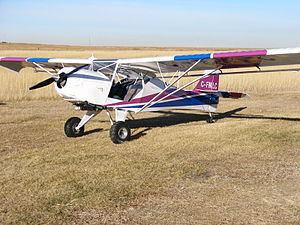Top speed 188 km/h Length 5.61 m | Wingspan 9.76 m First flight November 1984 | |
 | ||
Manufacturers SkyStar Aircraft, Denney Aerocraft | ||
The Denney Kitfox is a series of small side-by-side two-seat high-wing kit aircraft, designed and originally manufactured by Dan Denney and his company Denney Aerocraft of Boise, Idaho. The aircraft is amateur-built and not type-certified. Over 4500 kits have been delivered in 42 different countries.
Contents

A derivative of the Avid Flyer, the Kitfox was an early kit plane to feature quickly-folding wings that greatly simplify carriage and storage. The appeal of the aircraft was that it could be built by any handyman in a two-car garage and then towed to the airport with the wings folded. The landing gear may be easily converted to floats or skis.

Development and history

First flown in November 1984 from the Denney Aerocraft factory in Boise, Idaho, the Model 1 Kitfox was a two-seat STOL taildragger aircraft capable of flying from unimproved strips. The design was originally intended to use a new radial engine then in development and the early Kitfoxes had round cowls with bumps to accommodate the radial heads. Although this radial engine did not materialize, and a Rotax two-stroke engine was adopted instead, the "retro" radial cowling proved popular and was retained on many models. In 1984 a total of six Model 1 Kitfoxes were delivered and then the model range was expanded to include the improved Models 2, 3, 4, and Classic 4.

In June 1992 Denney Aerocraft sold the rights to the design to SkyStar Aircraft. Skystar started work on a new aircraft, the Kitfox Series 5. This aircraft was designed to be larger, with an increased useful load, cabin and cargo space, and to use certified aircraft engines. The Series 5 was produced as a conventional landing gear-equipped aircraft with the names Outback and Safari and also as a taildragger aircraft, the Vixen and Voyager. An employee consortium took over SkyStar Aircraft in January 2000, and this reorganized company launched the Kitfox Series 6. Later in 2000 the company also introduced the Kitfox "Lite Squared", a lightened version of the Kitfox Classic 4, as a two seat ultralight trainer for the single seat ultralight Kitfox Lite.
In 2002, SkyStar introduced the Kitfox Series 7. This aircraft could reach cruise speeds of up to 160 miles per hour (257 km/h) and a service ceiling above 25,000 feet (7,620 m). The Series 7 design conforms to the then-proposed Federal Aviation Administration Light Sport Aircraft category better than did the Lite Squared and it became the company's main model. As the LSA rules were further developed and gross weights increased, it became evident that a special version of the Kitfox Series 7, to be known as the Kitfox Sport, would not be needed and that all three Kitfoxes then in production - the Lite, Classic 4 and Series 7 would meet the revised the LSA category definition.
In late 2005 SkyStar Aircraft filed for bankruptcy. In April 2006, the assets of Skystar were purchased by Kitfox Aircraft, a newly formed company owned by John and Debra McBean. John McBean is a former SkyStar employee, having left the company in 2003.
Variants
Derivative designs
Since early 2009, Belite Aircraft, a new company based in Wichita, Kansas has produced the Belite Aircraft Superlite derivative of the Kitfox Lite single-seat ultralight design. Belite extensively redesigned the aircraft to incorporate carbon fibre wings, struts, spars and ribs, lowering the empty weight to 245 lb (111 kg).
Belite Aircraft "has acquired the production rights to a previously designed aircraft, the Kitfox Lite" and has "acquired the tooling, existing parts and manufacturing rights to the aircraft in March of 2009. As a condition of the transaction, they agreed to rebrand the airplane to prevent any confusion with the larger, two-place light sport Kitfox".
In Europe, the Apollo Fox and Aeropro Eurofox are based upon the Kitfox, with their Junkers flaps and folding wings. Both are Rotax-powered, side-by-side two-seaters, and are available either as taildraggers or with tricycle gear. The LAA's chief engineer, Francis Donaldson, tested a Eurofox and declared that "the manufacturer Aeropro has refined and greatly improved a kit plane classic".
Specifications (Kitfox Classic IV)
Data from Kitfox Aircraft Website
General characteristics
Performance
